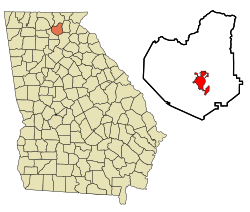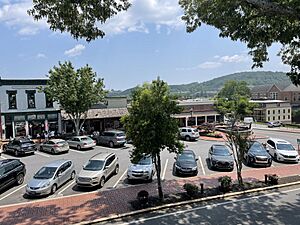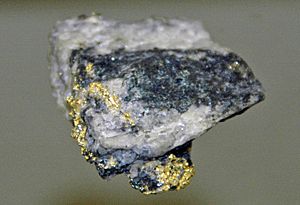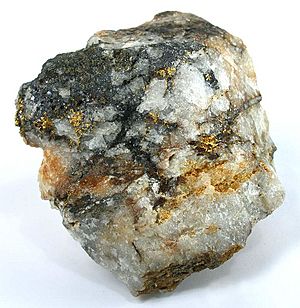Dahlonega, Georgia facts for kids
Quick facts for kids
City of Dahlonega
|
|||||
|---|---|---|---|---|---|
|
City
|
|||||

Historic Lumpkin County Courthouse, which now houses the Dahlonega Gold Museum Historic Site
|
|||||
|
|||||
| Nickname(s):
Gold City
|
|||||

Location in Lumpkin County and the state of Georgia
|
|||||
| Country | United States | ||||
| State | Georgia | ||||
| County | Lumpkin | ||||
| Government | |||||
| • Type | Council–manager | ||||
| • Body | City Council | ||||
| Area | |||||
| • Total | 8.87 sq mi (22.97 km2) | ||||
| • Land | 8.82 sq mi (22.84 km2) | ||||
| • Water | 0.05 sq mi (0.14 km2) | ||||
| Elevation | 1,450 ft (442 m) | ||||
| Population
(2020)
|
|||||
| • Total | 7,537 | ||||
| • Density | 854.83/sq mi (330.06/km2) | ||||
| Time zone | UTC-5 (EST) | ||||
| • Summer (DST) | UTC-4 (EDT) | ||||
| ZIP codes |
30533, 30597
|
||||
| Area code(s) | 706 | ||||
| FIPS code | 13-21240 | ||||
| GNIS feature ID | 0355420 | ||||
Dahlonega (/dəˈlɒnɪɡə/ DƏ-lon-IG-ə) is a city in Lumpkin County, Georgia, United States. It is the main city of Lumpkin County. In 2020, about 7,537 people lived there.
Dahlonega is located at the northern end of Georgia Highway 400. This highway connects Dahlonega to the big city of Atlanta. Dahlonega has been called one of the best places to retire.
Dahlonega was the site of the first major Gold Rush in the United States. This exciting event started in 1829. The Dahlonega Gold Museum Historic Site is in the middle of the public square. It was first built in 1836 as the Lumpkin County Courthouse.
In 1849, many local gold miners thought about going to California for their gold rush. But Dr. Matthew Fleming Stephenson, who worked at the Dahlonega Mint, tried to convince them to stay. He stood on the courthouse balcony and pointed to a distant hill. He said, "Why go to California? In yonder hill lies more riches than anyone ever dreamed of. There's millions in it." This famous phrase was later used by the author Mark Twain in his book The Gilded Age. Over time, it became the well-known saying, "Thar's gold in them thar hills."
Contents
Discovering Gold in Georgia
In 1829, gold was officially found in Georgia for the first time. When people heard the news, thousands of hopeful miners rushed to the mountains. They wanted to find the shiny yellow metal in the creeks and rivers.
At that time, the Georgia frontier was next to the Cherokee Nation. During the winter of 1829–1830, white gold miners started crossing the Chestatee River illegally. They were looking for gold in Cherokee lands. The Cherokee people complained, and U.S. troops were sent to remove the miners.
By 1831, Georgia's Governor Gilmer realized it was impossible to remove all the miners. He saw a chance to claim the Cherokee lands for Georgia. In 1832, Georgia created ten new counties from the former Cherokee Nation. This was done without respecting the Cherokee's rights. Lumpkin County, named after Governor Wilson Lumpkin, was created in December 1832. A year later, the town of Taloneka or Talonega became the new county seat. Its spelling was later changed to Dahlonega. This name comes from a Cherokee word meaning "yellow."
What Does Dahlonega Mean?
The city was first named "Talonega" by Georgia's government on December 21, 1833. The name was changed to "Dahlonega" on December 25, 1837. It comes from the Cherokee word Dalonige, which means "yellow" or "gold." The proper way to say Dahlonega in the Western Cherokee language is Dah-loe-nee-gee or Dah-lone-gay. The word Da-lo-ni-ge'i simply means "Yellow," not "gold."
The Dahlonega Gold Mint
Because so much gold was found in North Georgia, the United States decided to build a special mint in Dahlonega. A mint is a place where coins are made. This allowed local miners to bring their gold and get coins in return.
The Dahlonega branch mint was built in 1838. It made coins from 1838 to 1861. This mint, like the one in Charlotte, North Carolina, only made gold coins. These coins came in different values: $1.00, $2.50, $3.00 (only in 1854), and $5.00. It was much easier and safer for miners to get coins here than to ship their gold all the way to the main mint in Philadelphia, Pennsylvania. The Dahlonega Mint was small and made only a small part of the gold coins in the U.S. each year.
The mint closed in 1861 when the Civil War began. It closed because there wasn't enough gold or workers. After the war, the U.S. government decided not to open it again. By then, a new mint had opened in San Francisco. This new mint and the one in Philadelphia could handle all the country's coin needs. Because of this, Dahlonega coins are very valuable to coin collectors today.
The University of North Georgia
After the Civil War ended in 1865, the Dahlonega Mint building stayed closed. For a while, it was used as a place for U.S. troops to live and as a school for freed African American students.
In 1871, William P. Price, who was a Congressman from Dahlonega, asked the government to turn the empty mint building into a college. In 1873, the new North Georgia Agricultural College opened its doors in the old mint building. As the college grew, its name changed several times. It became North Georgia College, then North Georgia College and State University, and is now known as the University of North Georgia.
The University of North Georgia is one of only six senior military colleges in the U.S. It is also the second oldest public university in Georgia. The administration building, Price Memorial Hall, has a spire covered with real gold leaf from Dahlonega. Even the dome of the Georgia State Capitol in Atlanta is covered with Dahlonega gold!
Fun Things to Do in Dahlonega

In recent years, Dahlonega and Lumpkin County have become known as "the heart of the North Georgia Wine Country." There are many vineyards and five licensed wineries that attract lots of visitors.
The historic Dahlonega Square is a popular spot. It has gift shops, restaurants, art galleries, and places to taste wine. In 2015, Georgia Senator Steve Gooch officially recognized Lumpkin County as the Wine Tasting Room Capital of Georgia.
The city's local festivals also bring many people to visit.
- "Bear on the Square" is a three-day festival held every April. It celebrates the day a black bear wandered onto the square. It features bluegrass and old-time music.
- "Gold Rush Days" is a two-day event held every October. It attracts over 200,000 people!
Dahlonega is also home to the Holly Theatre. You can also visit Dockery Lake Recreation Area, which is 12 miles north of Dahlonega. It's a campground on a man-made lake where you can fish for trout.
Dahlonega's Location
Dahlonega is in the middle of Lumpkin County. U.S. Route 19 goes through the east side of the city. This road leads north to Blairsville and south to Atlanta. Georgia State Route 400, a highway that goes to Atlanta, ends about 5 miles south of Dahlonega.
The city is built on a low ridge. Water on the west side flows into Cane Creek, and water on the east side flows into Yahoola Creek. Both creeks flow south into the Chestatee River, which is part of the Chattahoochee River system. Crown Mountain, which is 1,720 feet tall, is in the southern part of the city.
Education in Dahlonega
Schools for Kids
The Lumpkin County School District has schools for students from pre-school to twelfth grade. It includes:
- Cottrell Elementary School
- Long Branch Elementary School
- Blackburn Elementary School
- Lumpkin County Middle School
- Lumpkin County High School
The district has about 215 full-time teachers and over 3,511 students.
Other Educational Places
- Wahsega 4-H Center: This is an outdoor education center and summer camp. It is owned by the University of Georgia.
- Camp Glisson: This is a year-round camp owned by the United Methodist Church.
Famous People from Dahlonega
- Cleo S. Cason: A military librarian.
- Sara Christian: NASCAR's first female driver.
- Steve Gooch: A Georgia state senator.
- Dallas Kinney: A photographer who won a Pulitzer Prize.
- Guy A. J. LaBoa: A lieutenant general in the United States Army.
- 6 Dogs: A rapper.
Sister City
Dahlonega has a "sister city" relationship with another city in the world. This helps people from both cities learn about each other's cultures.
See also
 In Spanish: Dahlonega (Georgia) para niños
In Spanish: Dahlonega (Georgia) para niños







